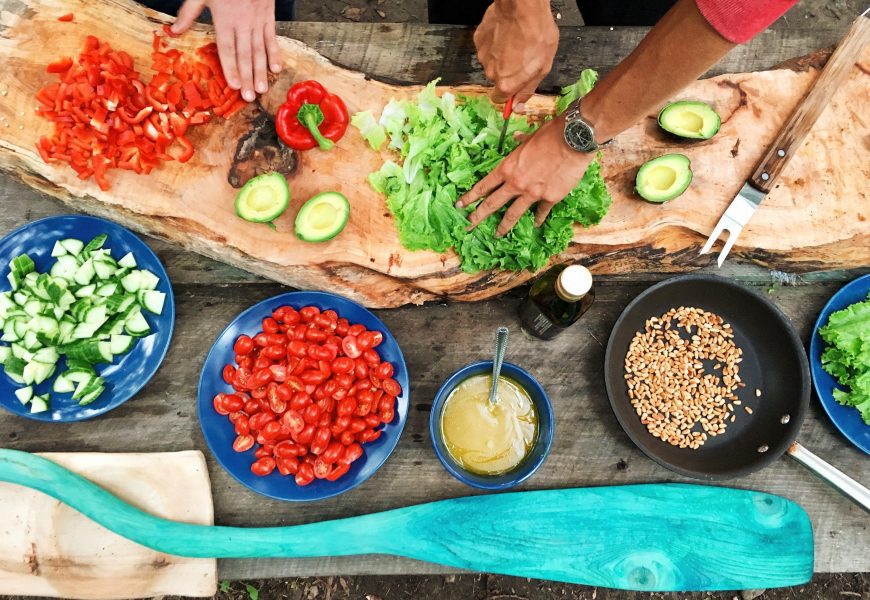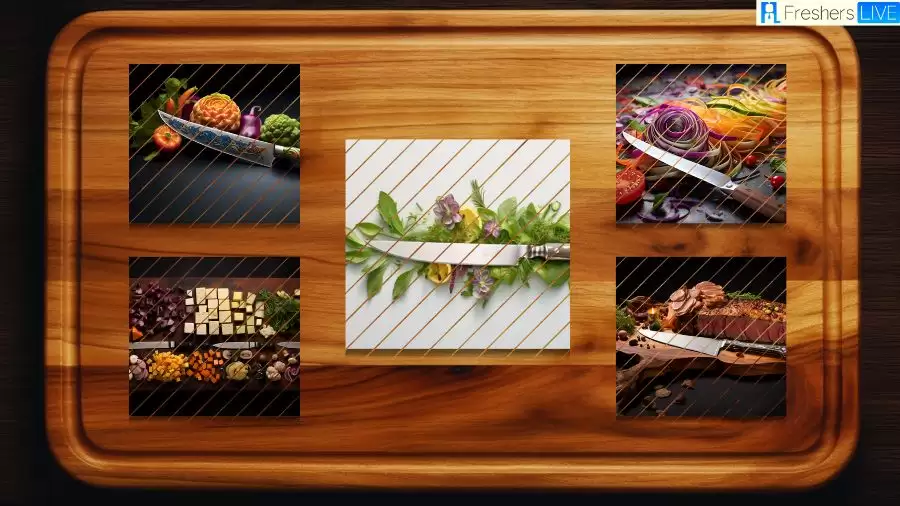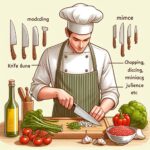Master the art of cutting with these top 10 knife skills for culinary excellence: Chopping, mincing, dicing, julienning, chiffonade, filleting, deboning, slicing, supreme, and tourne. Sharpen your culinary expertise and enhance your kitchen efficiency with these essential knife techniques.
Mastering knife skills is fundamental for any aspiring chef or home cooking enthusiast. Precise cuts not only improve the presentation of dishes but also ensure even cooking and better flavor distribution. Developing these key knife abilities will expedite your food preparation process, elevate the visual appeal of your meals, and vastly improve your culinary prowess.
As you learn to handle knives with precision and safety, you’ll find that cooking becomes less of a chore and more of a creative and enjoyable activity. Whether you are a novice starting your culinary journey or a seasoned cook aiming to refine your technique, these top knife skills will serve as the cornerstone of your kitchen craft. Committing to practice and mastering these techniques will open the door to a new level of confidence and sophistication in your culinary creations.
Introduction To Knife Skills
Masterful culinary creations begin with the basics, and no skill is more foundational than wielding a knife with confidence and precision. As the backbone of kitchen proficiency, knife skills set the stage for culinary excellence. Whether you’re an aspiring chef or a home cooking enthusiast, these skills are paramount in transforming raw ingredients into gastronomic works of art. The journey to expertise starts here, sharpening your abilities and slicing through the essentials.
Understanding The Importance Of Knife Skills In Cooking
Knife skills are far more than just slicing and dicing. They are about maintaining safety, improving efficiency, enhancing flavors, and creating visually appealing dishes. The way ingredients are cut affects cooking time and taste. Uniform cuts not only cook evenly but also contribute to the visual allure of a meal. A dish with neatly chopped ingredients reflects the chef’s expertise and attention to detail, making knife skills a true culinary asset.
Overview Of Essential Knife Types And Their Uses
Equipping yourself with the right knives is the first step in honing your culinary prowess. Each knife is designed with a purpose, and understanding which to use can elevate your kitchen performance.
| Knife Type | Primary Use |
|---|---|
| Chef’s Knife | Designed for versatility, it’s ideal for tasks like slicing, dicing, and mincing. |
| Paring Knife | Perfect for smaller, more intricate tasks such as peeling and trimming. |
| Bread Knife | Its serrated blade cuts through bread without crushing it. |
| Fillet Knife | Its flexible blade is tailored for removing skin and bones from meat and fish. |
| Santoku Knife | This Japanese all-rounder excels at slicing, dicing, and mincing with its unique scalloped edge. |
With this arsenal at your disposal, precise cuts and expertly prepared ingredients are within reach. Embrace the craft of knife skills, and the culinary world unfolds before you—one slice at a time.

Credit: www.fresherslive.com
Fundamental Knife Techniques
Mastering the art of knife skills is essential for any aspiring chef or home cook. With the right techniques, you can improve your efficiency, safety, and the overall quality of your dishes. Let’s dive into the top three knife techniques that will set the foundation for your culinary prowess.
The Claw Method: Protecting Your Fingers
The Claw Method is a safety technique that involves tucking your fingertips under your knuckles while holding the food item. This keeps your fingers safe from accidental cuts. Here’s how to master the Claw Method:
- Align your fingers on the product you’re cutting, tuck your fingertips towards your palm, and rest your knuckles against the blade.
- Keep your thumb behind your fingers at all times to avoid slicing it.
- Move the knife against the guide of your knuckles, slicing the item with a gentle rocking motion.
Rock Chop Vs. Cross Chop: When To Use Each
Rock Chop and Cross Chop are two different techniques used for mincing and chopping respectively.
| Technique | Usage | Method |
|---|---|---|
| Rock Chop | Used for mincing herbs and garlic. | Keep the tip of the knife on the cutting board and rock the knife up and down. |
| Cross Chop | Effective for chopping vegetables and nuts. | Lift the knife off the board between each chop and use a swift, downward motion. |
The Importance Of Honing And Sharpening Your Knife
A well-maintained knife is a chef’s best friend. Here’s why keeping your knife honed and sharpened is crucial:
- Honing realigns the blade’s edge, keeping it straight and true between sharpening sessions. Use a honing steel regularly before cooking.
- Sharpening removes material from the blade to create a new edge. Do this with a whetstone or a professional sharpener every few months, depending on the knife usage.
By incorporating these fundamental knife techniques, you’ll take the first step in creating dishes that not only taste great but are also visually stunning.
Essential Cuts And How To Master Them
Mastering knife skills is a foundational element of expert cooking that transforms simple ingredients into culinary masterpieces. It’s about precision and consistency, creating uniform shapes and sizes that not only cook evenly but also appeal to the eye. Whether you are a home cook or aspiring chef, refining your cutting techniques can elevate your kitchen game immensely. Here are the essential cuts and tips to help you wield your knife like a pro.
Julienne And Batonnet: Creating Uniform Sticks
The Julienne and Batonnet cuts are all about turning vegetables into neat, uniform sticks. The Julienne is typically about 2-3 mm thick, while Batonnet extends to roughly 6 mm.
- Start by trimming your vegetable into a uniform rectangle.
- Slice this rectangle lengthwise into even slabs for Batonnet, and then cut these slabs into sticks. For Julienne, make these slabs thinner before slicing into sticks.
- Use a steady hand and finger guards to ensure consistency and safety.
Practice is key to mastering these exacting cuts, leading to more professional presentations and quality.
Dicing: The Basics Of Small, Medium, And Large Cubes
Dicing involves cutting foods into perfect cubes of various sizes: small (brunoise), medium (macédoine), and large (parmentier).
- First, create flat surfaces by slicing off the ends of your vegetable.
- For small dices, start with a Julienne cut and then cross-cut into tiny cubes.
- For medium and large dices, first cut into thicker slabs or Batonnet sticks, then cross-cut accordingly.
Keeping your cubes uniform not only enhances the appearance of your dish but also ensures even cooking.
Chiffonade: The Art Of Thinly Slicing Leafy Greens And Herbs
The Chiffonade cut is ideal for herbs and leafy greens, creating elegant ribbons that are perfect as garnishes or in dishes where a light touch of flavor is needed.
- Stack leaves on top of each other, then roll them tightly like a cigar.
- Hold the roll firmly and slice through with a sharp knife, creating thin strips.
- Unroll the strips to reveal delicate ribbons that can elevate both flavor and presentation.
Use a sharp knife for a clean cut that doesn’t bruise the delicate greens. The key to a perfect Chiffonade is maintaining a gentle, consistent slicing motion.

Credit: www.amazon.com
Advanced Knife Skills
Elevating your culinary prowess requires a set of sophisticated knife skills that go beyond the basics. Understanding and mastering these advanced techniques can transform simple dishes into masterful culinary creations. This section of the blog post focuses on those refined knife skills that every aspiring chef should aim to perfect. From crafting intricate cuts to handling delicate proteins with finesse, these are the top skills to refine.
Tourne Cut: Crafting Seven-sided ‘footballs’
The tourne cut, a classic technique used in French cuisine, is ideal for giving vegetables a sophisticated and uniform shape perfect for high-end presentations. This method involves paring vegetables into a seven-sided, oblong shape resembling a football, which allows them to cook evenly. To master the tourne cut:
- Choose the right tool: a small, sharp paring knife is essential.
- Secure the vegetable by holding it firmly against the cutting board.
- Make a series of rolling cuts, turning the vegetable after each cut to create the seven sides.
Filleting Fish: Techniques For Delicate Proteins
Filleting fish is an art that requires precision and a gentle touch. The goal is to separate the flesh from the bones with minimal waste and without damaging the delicate protein. Key points include:
- Use a flexible fillet knife for better control and precision.
- Start by making an incision behind the gills and work your way down the spine.
- Glide the knife along the bones, using smooth, long strokes to avoid tearing.
Butterfly And Spatchcock: Preparing Poultry For Even Cooking
The butterfly and spatchcock techniques involve removing the backbone and flattening the bird, which promotes quicker and more even cooking. This is particularly useful for larger birds or when grilling. Here’s how to execute these techniques flawlessly:
| Step | Butterfly | Spatchcock |
|---|---|---|
| 1 | Cut along both sides of the backbone with kitchen shears. | Cut along one side of the backbone with kitchen shears. |
| 2 | Remove the backbone and open the bird like a book. | Flip and press down firmly to flatten the bird. |
| 3 | Press down to flatten, and make small cuts in the keel bone if necessary. | Optionally remove the sternum for easier eating. |
Knife Maintenance And Safety
The art of cooking is much like a dance; graceful, precise, and at times, sharp. Having your knives in pristine condition is not just a matter of performance; it’s about safety too. A dull knife can slip and cause injury, while a well-maintained blade cuts cleanly and predictably. Master chefs know that knife maintenance and safety are as crucial as the cutting techniques themselves. Here’s how to hone the unseen skills of knife care — because even the best knives demand respect and attention.
Proper Knife Storage to Maintain Edge and Safety
Proper Knife Storage To Maintain Edge And Safety
Just as a musician carefully places their instrument back in its case, a culinary artist must store their tools correctly to preserve their life. Proper knife storage is paramount. Consider these options:
- Magnetic strips: Affix knives safely on the wall and out of children’s reach.
- Knife blocks: Traditional and efficient, they protect the blades from damage.
- Drawer inserts: Organize your knives in a drawer with a designed insert to prevent blades from touching.
Cleaning and Caring for Your Knives: Best Practices
Cleaning And Caring For Your Knives: Best Practices
To ensure your knives remain sharp and rust-free, follow these cleaning and caring tips:
- Hand wash: Always hand wash knives with mild soap and warm water.
- Dry immediately: Prevent corrosion by thoroughly drying knives right after washing.
- Use sharpeners: Regularly sharpen your knives to maintain the edge.
- Honing rods: Straighten the blade’s edge with a honing rod weekly.
- Professional servicing: Yearly, have your knives professionally sharpened.
Avoiding Common Knife Injuries
Avoiding Common Knife Injuries
Safe knife handling is essential to preventing accidents in the kitchen. Adhere to these safety tips to keep your fingers intact:
- Use the right knife: Match the knife to the job at hand, and avoid forcing the wrong type in the wrong cut.
- Cut away from the body: Always direct the blade away from your hands and body.
- Keep fingers clear: Tuck your fingers away while chopping by using the “claw grip” technique.
- Secure the cutting board: A stable board is critical. Place a damp cloth underneath to prevent slips.
- Stay focused: Distractions while cutting can be dangerous. Give your blade the attention it deserves.
Applying Knife Skills In Culinary Creations
Mastering the art of knife skills is more than just a technical necessity; it’s the cornerstone of transforming simple ingredients into artistic culinary creations. Applying these knife skills in cooking not only optimizes the cooking process but elevates the visual and sensory experience of the dish. Precision cuts can blend flavors more harmoniously and give a professional edge to home-cooked meals. Let’s delve into how keen knife expertise can impact timing, presentation, and overall culinary proficiency.
Timing And Precision: Integrating Knife Skills Into Cooking
In the ballet of the bustling kitchen, timing is everything. Quality cuts impact cooking times, ensuring each ingredient is perfectly tender or crisply done. Here’s how to incorporate these skills:
- Uniformity: Uniform cuts ensure even cooking. Dice onions uniformly for consistent caramelization or slice potatoes evenly to avoid undercooked pieces in your gratin.
- Mise en place: Prepare all ingredients prior to cooking to streamline the cooking process and maintain focus on timing and the order of operations.
- Herb prep: Delicate herbs require a sharp knife for clean cuts that preserve flavor and color, enhancing the finished dish.
Presentation And Plating: Using Knife Skills To Enhance Visual Appeal
The artistry of a dish can be greatly accentuated by impressive knife skills. Meticulous cuts add elegance and structure to the presentation:
- Julienne: These matchstick-like cuts add finesse to salads and garnishes, offering a pleasing aesthetic.
- Chiffonade: Rolling herbs or leafy vegetables and slicing them thinly creates delicate ribbons perfect for a beautiful garnish.
- Supreme citrus: Removing the membrane from citrus fruits can create clean, jewel-like segments that elevate any plate’s visual allure.
Practice Makes Perfect: Developing Speed And Consistency
Achieving dexterity and speed with knife work is a game-changer in the kitchen. Here’s how frequent practice can excel your culinary capabilities:
Repetition: Regular practice of different cutting techniques will naturally increase speed without sacrificing precision.
Muscle memory: Over time, your hands will remember movements, making tasks such as dicing onions or filleting fish second nature.
Consistency: Consistently cut ingredients not only cook more evenly but also ensure a professional and appealing dish every time.
Immaculate knife skills are at the core of culinary finesse. By honing these techniques, you can guarantee that each slice contributes to a masterful culinary creation. Keep practicing, be patient with the process, and watch as your dishes take shape with both grace and precision.

Credit: www.mytoptenlists.com
Frequently Asked Questions For Top 10 Knife Skills For Masterful Culinary Creations
What Are Essential Knife Skills For Chefs?
Essential knife skills for chefs include proper grip, accurate rocking motion for chopping, and mastering the julienne and dice. These foundational techniques increase efficiency and safety in the kitchen. Learning to maintain knife sharpness is also crucial.
How To Improve Knife Cutting Precision?
Improving knife cutting precision involves practicing consistent cutting techniques. Use the claw grip to guide cuts, and keep the knife blade against the guiding knuckles. Regular sharpening and using the right knife for each task are key.
Can Knife Skills Enhance Cooking?
Absolutely, refined knife skills can significantly enhance cooking. Uniformly cut ingredients cook evenly and help in achieving the desired flavor and texture. Better knife skills also speed up food preparation, allowing for more focus on other aspects of cooking.
What Is The Safest Way To Hold A Knife?
The safest way to hold a chef’s knife is by using a pinch grip. Pinch the blade’s base between your thumb and forefinger, wrapping the remaining fingers around the handle. This grip improves control and reduces the risk of slipping.
Conclusion
Mastering knife skills is a game-changer for any cooking enthusiast. These top 10 techniques will elevate your kitchen artistry, ensuring safety and efficiency. Practice leads to perfection, and precision chopping can become second nature. Embrace these skills to enhance flavors, textures, and presentation.
Happy slicing!







